Donald Duck in Close-Up #10

It’s been nearly 90 years since Donald Duck was born, and much has been written about him over the years. Many writers, including this one, have chosen to focus on one particular aspect of Donald’s character: his violent temper. The Duck’s short fuse was, after all, a spectacular, attention-getting trait. His first temper tantrum in 1934 stamped him as a dynamic, fascinating new character, and as his outbursts grew more frequent and more hysterical, audiences grew more intrigued with the pugnacious little crank. But of course he was not simply a one-dimensional character, and as he grew and developed, the Disney writers gave him additional characteristics. Donald wasn’t merely bad-tempered, he was also lazy, mischievous, vengeful, and selfish. As Walt Disney told an interviewer in 1935, “He’s a composite of all the people you don’t like and a few of the people you do.”
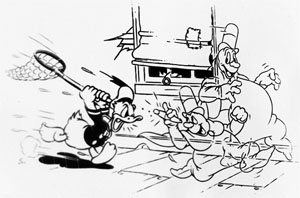 One other aspect of Donald’s personality emerged in short order: he was a coward. Time and again, both on the screen and in the comics, Donald issued a challenge to some hulking bully whose back was turned—then ran for cover the moment he was directly threatened with danger.
One other aspect of Donald’s personality emerged in short order: he was a coward. Time and again, both on the screen and in the comics, Donald issued a challenge to some hulking bully whose back was turned—then ran for cover the moment he was directly threatened with danger.
Donald’s cowardice was seldom stressed in the movies; but when it was, it suggested a golden opportunity for comedy situations: ghosts, witches, and other spooky creatures. If ordinary mortal menaces brought out Donald’s faint-hearted side, he was a sitting duck for the supernatural. The Disney studio explored this angle as early as 1937, in Lonesome Ghosts, recently revisited here on Cartoon Research by Jim Korkis. Here Donald joined Mickey Mouse and Goofy in the Ajax Ghost Exterminator Company, taking on a haunted houseful of ghosts who were simply bored and looking for recreation. None of the three showed great expertise at their jobs, but Donald was so jumpy that the ghosts immediately singled him out for taunting. At the end of the picture, when the ghosts were routed from the premises—by sheer accident—Donald, of course, led his companions in jeering at the departing spirits, as if he had been the fearless leader all along.
Tellers of ghost stories have two broad options: they can picture the ghosts and goblins as genuine supernatural beings, or they can reveal some hidden rational explanation for the spooky goings-on. David Gerstein has pointed out that the Disney studio had it both ways in 1936–37: Lonesome Ghosts, the theatrical short, depicted ghosts who were really ghosts, while the Mickey Mouse newspaper comic strip mounted a corresponding continuity in which the ghosts turned out to be an illusion, staged by a gang of crooks to scare prying eyes away from their old-house hideout. (This angle had actually been planned for the film too, but abandoned during story development.) In both cases, whether facing otherworldly spirits or human malefactors, Donald proved himself lacking in courage.
Considering the rich vein of comedy that had been revealed in Lonesome Ghosts, the Disney writers showed remarkable restraint in this area; no further Donald-haunted-house adventures were forthcoming. In the early 1940s, when live-action comics like Abbott and Costello and the Three Stooges were running afoul of the spirit world, the Duck did not follow suit. (Admittedly, he was otherwise occupied at the time: joining the armed forces in a series of service comedies, and traveling through Latin America in Saludos Amigos and The Three Caballeros, along with his regular series of short cartoons.)
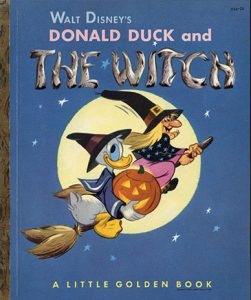 Strictly speaking, there were still no ghostly encounters in store for Donald in the immediate postwar years—but now there were some cartoons that could, at the least, be termed nightmarish. We’ve considered one of them, Donald’s Crime, in this space, and even more recently our friend Devon Baxter has followed up with a close examination of Duck Pimples. Both these cartoons drew heavily on the then-fashionable conventions of film noir, plunging Donald into a dark world where sinister forces came out of nowhere in a kind of stream-of-consciousness illogic. A 1944 release, Donald Duck and the Gorilla, was based on an alternate tradition of quasi-horror films: the gorilla or other terrifying beast pursuing the protagonist, preferably through a house with a lot of dark spaces. (Mickey Mouse had drawn on that same tradition as far back as 1930 in The Gorilla Mystery.)
Strictly speaking, there were still no ghostly encounters in store for Donald in the immediate postwar years—but now there were some cartoons that could, at the least, be termed nightmarish. We’ve considered one of them, Donald’s Crime, in this space, and even more recently our friend Devon Baxter has followed up with a close examination of Duck Pimples. Both these cartoons drew heavily on the then-fashionable conventions of film noir, plunging Donald into a dark world where sinister forces came out of nowhere in a kind of stream-of-consciousness illogic. A 1944 release, Donald Duck and the Gorilla, was based on an alternate tradition of quasi-horror films: the gorilla or other terrifying beast pursuing the protagonist, preferably through a house with a lot of dark spaces. (Mickey Mouse had drawn on that same tradition as far back as 1930 in The Gorilla Mystery.)
Meanwhile, the spirit world held one more adventure in store for Donald. Trick or Treat (1952) was designed specifically as a Halloween attraction, and in succeeding years it has become a cult favorite among cartoon fans.
The premise of this cartoon is ingenious: it reverses the arc of the earlier stories. We’ve seen Donald intimidated into trembling fear by ghosts and other unseen menaces, real or imagined. This time it’s the other way around; the witch is real and has genuine supernatural powers, but Donald is oblivious—at first. By reel’s end he has learned, the hard way, a new respect for the paranormal. Unlike the earlier films, Trick or Treat pictures all this in a harmless, lighthearted way. Donald is on the receiving end of some potent witchcraft here, but it’s all handled in a spirit of fun and amounts to so much magical slapstick. The witch, Hazel, voiced by animation legend June Foray, is less frightening than endearing.
Since Halloween is just around the corner, and since real trick-or-treating is discouraged this year in the time of Covid, this is a good time for a fresh look at the cartoon. Devon Baxter has kindly provided one of his “Baxter’s Breakdowns,” a scene-by-scene guide to the animators who brought Trick or Treat to life.
In the early 1950s the Donald Duck series, the mainstay of the Disney shorts department for more than a decade, was beginning to slow down. All of the traditional Disney cartoon stars, in fact, were making fewer and fewer new screen appearances. Reissues of their earlier shorts took up some of the slack in the release schedule—but, increasingly, the studio was producing “specials:” cartoons that were part of no particular series, and sometimes introduced new characters. As production of Trick or Treat began to take shape late in 1951, some in the studio took note of its unusual seasonal appeal and began to eye it as something out of the ordinary. Then-advertising executive Card Walker took a particular interest in it. In December 1951 Walker sent a memo to Leo Samuels in Disney’s New York office, calling Trick or Treat to his attention and suggesting that he might “call it a ‘special’ like Lambert the Sheepish Lion, Susie, the Little Blue Coupe, and The Little House.”
In succeeding months Walker maintained his interest in Trick or Treat, and prevailed on Jack Hannah’s production unit to speed up work on the film in order to have it ready for a Halloween release. In February 1952 he arranged a screening of the rough animation reels for a studio audience. He reported that “the picture was received with unusual enthusiasm by everyone concerned. In my opinion, we have an excellent short subject and will be able to do a great deal of talking about it.”
Ultimately Trick or Treat was released as a regular entry in the Donald Duck series, but its release was carefully timed to coincide with Halloween 1952, and the film did receive a special promotional campaign. Much of this was built around the title song, written by Mack David, Jerry Livingston, and Al Hoffman. This song was remarkable in itself: David, Livingston, and Hoffman were all experienced tunesmiths who had, collectively, written numerous songs for other movie studios. By 1948 they had contracted with Disney and were at work on the songs for Cinderella. But in the usual bustling atmosphere of the Disney studio, the team was drawn into other projects as well, and floated several song ideas for Alice in Wonderland that were not used in the finished film (and one that was: the novelty number “The Unbirthday Song”).
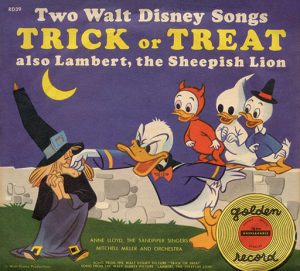 As early as Card Walker’s December 1951 memo, the team’s “Trick or Treat” song was recognized as having “good commercial possibilities for a Halloween release.” The studio didn’t stop with promoting the song in the popular-music market; they also contracted with the RCA Victor record label to produce a special recording which was issued to coincide with the film’s release (and, of course, with Halloween). The RCA record album turned out to be an impressive affair: two 78 rpm discs (or one 45 rpm single) retelling the story of the film. The script was written by Ralph Wright, who had been the head of the story team for the film, and the recording featured return appearances by Clarence Nash, as the voice of Donald Duck, and June Foray, not only reprising her role as Witch Hazel but also narrating the story. Moreover, the records were released in an elaborate package containing an illustrated storybook, coloring-book pages, and punch-out puppets and a puppet stage! Greg Ehrbar has written at length on this special recording in an earlier installment of Cartoon Research. RCA eagerly cooperated in promotion of the record album, screening a print of the film at its August 1952 national convention to help motivate record distributors and dealers from across the nation.
As early as Card Walker’s December 1951 memo, the team’s “Trick or Treat” song was recognized as having “good commercial possibilities for a Halloween release.” The studio didn’t stop with promoting the song in the popular-music market; they also contracted with the RCA Victor record label to produce a special recording which was issued to coincide with the film’s release (and, of course, with Halloween). The RCA record album turned out to be an impressive affair: two 78 rpm discs (or one 45 rpm single) retelling the story of the film. The script was written by Ralph Wright, who had been the head of the story team for the film, and the recording featured return appearances by Clarence Nash, as the voice of Donald Duck, and June Foray, not only reprising her role as Witch Hazel but also narrating the story. Moreover, the records were released in an elaborate package containing an illustrated storybook, coloring-book pages, and punch-out puppets and a puppet stage! Greg Ehrbar has written at length on this special recording in an earlier installment of Cartoon Research. RCA eagerly cooperated in promotion of the record album, screening a print of the film at its August 1952 national convention to help motivate record distributors and dealers from across the nation.
Aided by this promotional push, Trick or Treat made a hit with audiences in 1952 and has continued to delight new audiences since then. Witch Hazel did not appear in subsequent Disney films, but she was too good to lose; within two years she began to turn up again in Warner Bros. and MGM cartoons—arguably not the same character, but still named Witch Hazel and still voiced by June Foray.
For more about Trick or Treat, please check Jim Korkis’ previous column on the film – posted here. In the meantime, Happy Halloween everyone!
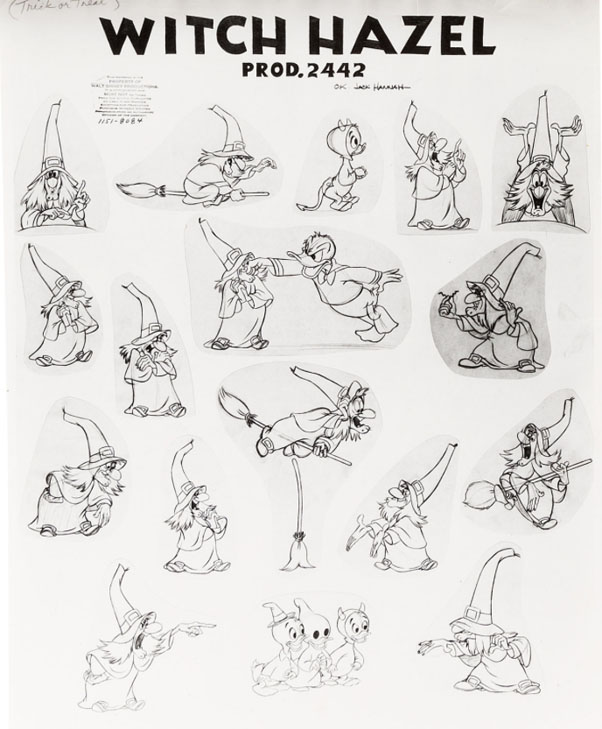


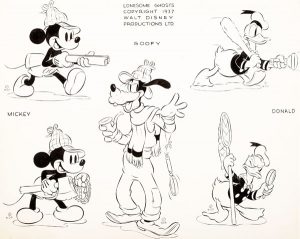

 J.B. Kaufman is an author and film historian who has published and lectured extensively on Disney animation, American silent film history, and related topics. He is coauthor, with David Gerstein, of the Taschen book “Walt Disney’s Mickey Mouse: The Ultimate History,” and of a forthcoming companion volume on Donald Duck. His other books include “The Fairest One of All,” “South of the Border with Disney,” “The Making of Walt Disney’s ‘Fun and Fancy Free’,” and two collaborations with Russell Merritt: “Walt Disney’s Silly Symphonies” and the award-winning “Walt in Wonderland: The Silent Films of Walt Disney.”
J.B. Kaufman is an author and film historian who has published and lectured extensively on Disney animation, American silent film history, and related topics. He is coauthor, with David Gerstein, of the Taschen book “Walt Disney’s Mickey Mouse: The Ultimate History,” and of a forthcoming companion volume on Donald Duck. His other books include “The Fairest One of All,” “South of the Border with Disney,” “The Making of Walt Disney’s ‘Fun and Fancy Free’,” and two collaborations with Russell Merritt: “Walt Disney’s Silly Symphonies” and the award-winning “Walt in Wonderland: The Silent Films of Walt Disney.”







































Bea Benaderet did Hazel’s first appearance in the Warners’ cartoons, 1954’s “Bewitched Bunny” — June Foray took over the role with 1955’s “Broomstick Bunny” after “Burns & Allen” went to a 39-week filmed shooting schedule (instead of 26 bi-weekly live shows) and no longer had time to do voices for Warners.
Well, dog my cats — just days after UPA’s “The Ragtime Bear” was posted on this site, along comes another cartoon with a banjo solo! But as sadistic square dance callers go, Witch Hazel is no Hillbilly Hare.
One of the cool, special things about this cartoon is the custom opening sequence.
Some of the effects in original RKO prints, such as the musically timed camera pans and an animated brush which magically paints the title on the window, were lost in the reissue. Thankfully, Erik has generously shared these lost titles on his YouTube Channel for us to see:
https://www.youtube.com/watch?v=-SiTJFjVvH0
It may not be “Hillbilly Hare”, but June’s performance really sold it (with some help from the talented sound effect department).
Always enjoyed this one – Ralph Wright was a strong story-man.
Nice to have the full animator credits. I never heard the name Ken Walker before – his scenes of Donald dancing look more stylised than those of the other animators – did he mainly work on the TV series?
The rest of the animator casting is interesting as well. Jack Hannah/Duck unit regulars Bill Justice, Volus Jones and George Kreisl appear in rotation throughout the short, with a general tendency (though not rigidly followed) for Justice to focus on scenes of the kids and Hazel, and Jones to focus on scenes of Donald. Al Coe, another regular in the unit, is only cast on the song sequence at the centre of the cartoon, plus one later shot of Donald running into the camera. Features animator Don Lusk gets screen credit for his “guest spot” animating two key Hazel sequences: her introduction and the scenes at the cauldron.